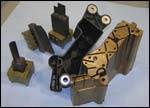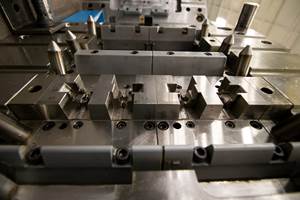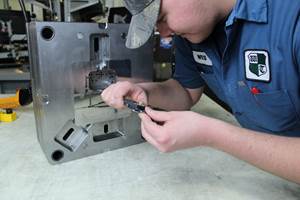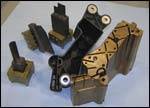Selecting the Right Graphite Grade
Selection of the proper graphite grade requires an understanding of the physical properties and how they affect electrode fabrication and performance during the EDM process.
Small featured, detail intense cavities that cannot be manually polished need to come out of the EDM tank with the desired surface finish. To achieve this goal, the graphite grade selected needs to have the characteristics and properties that will meet these requirements. Typically, graphite in the ultrafine classification is used for this application. Selection of the right grade for the job requires an understanding of the important physical properties.
Properties and Characteristics
Ultrafine
Within the ultrafine classification there is a wide range of typical properties and microstructures for each of these graphite grades. Generally, graphite that has a balanced combination of high strength, small particle size and uniform microstructure produces cavities with tight tolerances, fine detail and excellent surface finish for quality plastic parts.
Uniform Microstructure
The most important characteristic for overall performance during electrode fabrication or EDM is uniform microstructure with an even distribution of small pores and particles. These materials tend to have consistent microstructure from block to block and year to year due to the quality of manufacturing. Materials that have random voids or agglomerates offer less predictable performance. Predictable results are essential, particularly in applications that have extended manufacturing times and costs, such as molds with critical dimensions, tolerances and use of an EDM surface finish rather than chemical or hand polishing.
Hardness and Strength
The properties that are important for electrode fabrication are a shore hardness range between 70 and 80 with flexural strengths above 13,000 psi. Materials in this range produce good, clean edges at the top of the thousands of holes necessary for the grills. Machining feeds and speeds are lower on materials with shore hardness above 80-typically 1 percent slower for each hardness value above 80. Small grain graphite materials that are too hard can cause difficulties in electrode fabrication, as these materials often chip at the rim of the hole during machining. They also can be very abrasive on cutters, causing wear that can impact the integrity of the hole diameter. High cutter wear and chipping increases the cost of the job. Soft graphites can also cause problems by clogging the flutes of the cutters, slowing down the machining process or packing the hole with dust that can stress the hole walls.
Flexural strengths above 13,000 psi allow thin, deep ribs to be machined into the electrode without breakage. Because these electrodes have detailed features, the electrode fabrication process can be long and the profitability of the job demands that as few electrodes as possible are machined.
Electrodes
Electrode wear during the EDM process becomes very important as high wear means the electrode will need frequent redressing. Particles released from the electrode into the gap can cause cosmetic blemishes in the cavity, and slower EDM times. Excessive debris gap from the electrode cause the adaptive controls that monitor the gap to retract the ram, thus widening the gap and increasing jump cycles to clear the gap of large particles. Flushing through the electrode is not practical in this type of application, so it is important to keep debris at a minimum. Graphites with low strengths and loose microstructure allow large particles to be ejected into the gap. Graphite with uniform microstructure and small particle size resists wear better than graphite with a grain size larger than five microns or nonuniform microstructure. Even wear is necessary to produce a cavity with correct tolerance.
Electrode orbiting allows the gap to clear and produces a better surface finish. Orbiting electrodes with thin ribs requires that the material have high strengths to eliminate deflection, cracking or breaking of the rib as it is orbited. These same characteristics also influence the surface finish that can be produced. This is particularly important inside the holes and ribs for good release of plastic from the mold.
Using a high quality electrode material to obtain the desired detail and surface finish in the cavity for good plastic release increases the productivity and profitability of such jobs.
Performance
As new materials enter the ultrafine classification, EDMers are seeing improved performance. Unique graphite grades offer advantages such as:
- Average particle size under four microns for fine surface finish and wear resistance;
- Elevated flexural strength above 15,000 psi for thin rib detail;
- Ideal hardness range for ease of electrode fabrication.
These attributes are important when the electrode has small features that cannot be polished and conservation of the electrode is important while maintaining good metal removal rates. Using grades with these physical properties will generally reduce electrode wear by 10 percent and improve surface finish by 5 percent. Grades with 15 percent higher flexural strength also are the best graphites in this classification for the production of very thin walled rib electrodes.
When selecting a graphite grade for demanding applications such as speaker molds (see Speaker Grill Applications table at end of article), understanding how the physical property values affect the finished cavities is important. Selecting the best graphite for the job will produce a quality cavity. Since the surface finish of the cavity is a mirror image of the microstructure of the electrode, selecting the best grade is important. Once the cavity is completed and the first plastic parts have been run, any sticking problems caused by inconsistencies in the cavity may mean that the cavity will need to be reworked or adjusted. The initial cost of premium graphite is out-weighed by the value derived from the performance of the graphite.
| Speaker Grill Applications |
| Plastic speaker grills can be a challenge for moldmakers with their small features that require fine surface finishes for a clean release of the plastic part. Often, due to the thousands of small holes, snap closures and thin strengthening ribs, the molds are not polished. Instead, the desired surface finish is obtained in the EDM tank. A typical surface finish of 4-6 Rmax is necessary in order to prevent plastic sticking in the mold during release. In order to obtain this fine surface finish during the EDM process, graphite with a uniform microstructure and small particle size is required for the electrode. Since the cavity is a mirror image of the electrode and the final plastic part is a mirror image of the cavity, it is important to start with the best electrode material possible to obtain the best plastic parts.
Speaker grills are one of the most demanding jobs with thousands of holes on one side and thin ribs on the other side of the mold. From electrode fabrication through the EDMing of the cavity, this application requires high strength, fine grain graphites from the ultrafine classification, averaging a particle size between one and five microns. Selection of the proper grade requires an understanding of the physical properties and how they affect electrode fabrication and performance during the EDM process. |
Related Content
Maintaining a Wire EDM Machine
To achieve the ultimate capability and level of productivity from your wire EDM on a consistent, repeatable and reliable basis, regular maintenance is a required task.
Read MoreExtensive Evaluations Build The Plastek Group’s EDM Arsenal
Sinker and wire EDMs selected for speed, volumetric accuracy, surface finish, reliability, cost of ownership and extensive warranty.
Read MoreMachine Monitoring Platform Improves Machine Utilization, On-Time Delivery
Using data from a machine monitoring platform, Westminster Tool added almost 75 hours of capacity per week by shortening warmups and starting CNC and EDM machines sooner.
Read MoreMold Builder Meets Increased Domestic Demand With Automated Cells
Burteck LLC experienced significant demand increases due to reshoring and invested in automated machining cells to step up its production output quickly and avoid losing business.
Read MoreRead Next
A Double Whammy
The solution to solving problems associated with EDMing high copper alloy work metal involves finding the right graphite electrodes.
Read MoreHow to Use Strategic Planning Tools, Data to Manage the Human Side of Business
Q&A with Marion Wells, MMT EAB member and founder of Human Asset Management.
Read MoreHow to Use Continuing Education to Remain Competitive in Moldmaking
Continued training helps moldmakers make tooling decisions and properly use the latest cutting tool to efficiently machine high-quality molds.
Read More_970x90 1.png;maxWidth=970;quality=90)







_300x250 4.png;maxWidth=300;quality=90)


.jpg;maxWidth=300;quality=90)










_300x250 3.png;maxWidth=300;quality=90)







